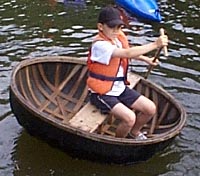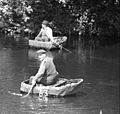Coracle facts for kids
The coracle is a small, very light boat. People used them in Wales, parts of Western and South West England, Ireland, and Scotland. The word "coracle" also describes similar boats from India, Vietnam, Iraq, and Tibet. The word "coracle" comes from the Welsh word cwrwgl. This is like the Irish and Scottish Gaelic word currach. People have used the word in English since the 16th century.

Contents
What are Coracles Like?
Coracles are shaped like an oval, a bit like half a walnut shell. They are built with a frame of split willow branches. These branches are twisted together and tied with willow bark. Long ago, the outside layer was made from animal skin, like horse or bullock hide. These skins were covered with a thin layer of tar to keep water out.
Today, coracles are often made with calico or canvas covered in tar. Some are even made from fibreglass. Asian coracles are made differently. They use bamboo for the frame. To keep water out, they use a layer of resin and coconut oil.
Coracles do not have a keel (a fin-like part under a boat). Their flat bottom spreads the boat's weight evenly. This means they can float in very shallow water, sometimes just a few inches deep. This makes them perfect for rivers.
Different Designs
Coracles have different designs depending on the river they are used on. For example, the Teifi coracle is flat-bottomed. This helps it in the shallow, fast-moving parts of the River Teifi in summer. The Carmarthen coracle is rounder and deeper. It is used in the tidal waters of the River Tywi, where there are no rapids.
Teifi coracles are made from local wood. They use willow for the main body, called "lats." Hazel wood is used for the rim around the top, called "Y bleth" in Welsh. For a long time, Tywi coracles were made from sawn ash wood. Now, many working boats are made from fibreglass. Teifi coracles do not use nails; the twisted lats make them strong. Carmarthen coracles use copper nails and are not twisted.
How They Are Used
Coracles are great for fishing because they do not scare the fish or stir up the water. A person can control a coracle easily with one arm. The other arm can manage a fishing net. Often, two coracles work together with one net between them.
The coracle is moved with a special paddle that has a broad blade. These paddles also have different designs for different rivers. The paddler uses a "sculling" action. This means the blade makes a figure-of-eight pattern in the water. The paddle is used near the front of the coracle, pulling the boat forward. The paddler faces the direction they are going.
A Welsh coracle is so light that a person can carry it on their back. There is a Welsh saying: 'Llwyth dyn ei gorwgl' — which means "the load of a man is his coracle."
History of Coracles
Coracles were made for the fast-flowing streams in Wales, Britain, and Ireland. These boats are very old. Julius Caesar saw them in Britain in the 1st century BC. Archaeologists think they have found parts of a coracle in a Bronze Age grave near Dalgety Bay. Other old coracle remains have been found at Corbridge and near Ferriby.
Coracle fishing is often done by two people. They stretch a net across the river between their two coracles. Each person paddles with one hand and holds the net with the other. When a fish is caught, both fishermen pull up their end of the net. This brings the two coracles together. Then, they can grab the fish and put it into the boat.
Coracles Today
Coracles are not used as much today as they once were. You can still see them in tourist areas of West Wales. Sometimes, you might spot them in Shropshire on the River Severn. There is even a public house (a pub) in Sundorne, Shrewsbury, called "The Coracle." Its sign shows a person using a coracle on a river.
The Welsh Rivers Teifi and Tywi are the best places to find coracles in Wales. On the Teifi, they are often seen between Cenarth, Cilgerran, and Llechryd.
In 1974, a man named Bernard Thomas from Llechryd crossed the English Channel to France in a coracle. It took him 13 and a half hours. This journey showed how the Bull Boats of the Mandan Indians in North Dakota might have been inspired by coracles. Some believe Prince Madog brought coracles to America in the 12th century.
For many years until 1979, a coracle maker from Shrewsbury named Fred Davies became famous among football fans. He would sit in his coracle during Shrewsbury Town FC home matches at Gay Meadow. His job was to get the footballs that landed in the River Severn. Fred Davies passed away in 1994, but his story is still remembered by the club.
The Coracle Society
The Coracle Society is an organization in the UK. Sir Peter Badge started it in 1990. The society wants to:
- Learn more about coracles, curraghs, and similar boats. This includes how they are made and used, and studying and collecting them.
- Support fishing that uses coracles.
- Encourage coracle races and events.
- Print a newsletter about coracles.
- Help people find materials to build coracles.
- Organize demonstrations, courses, exhibitions, talks, and lectures about coracles.
Many members of the Society show coracles at events. Some also teach people how to build them. Terry Kenny, the current chairman, runs several courses each year at the Green Wood Centre. You can find some of this year's events on the official Coracle Society website: http://www.coraclesociety.org.uk.
The Society was at the 2005 Shrewsbury River Festival. They had different coracles on the River Severn. There is also an Annual Coracle Regatta held in Ironbridge every year on the August Bank Holiday Monday. The Green Wood Centre organizes it. Anyone with a coracle can join in. Each year, new people come with coracles they made that same weekend at the Green Wood Centre with local coracle maker Terry Kenny.
The third Coracle Challenge took place in Shrewsbury on May 19, 2009. This event raised money to support Macmillan Cancer Support.
Safety
A coracle is not a very stable boat. Because it sits "on" the water instead of "in" it, currents and wind can easily move it. The Coracle Society has written a guide to help people use coracles safely.
Similar Boats
The oldest instructions for building a coracle-like boat are on a 4000-year-old clay tablet. This cuneiform tablet describes how the Mesopotamian god Enki told Atra-Hasis to build a round "ark." This tablet is about 2,250 years older than the famous flood myths, which do not have such building details. The earliest known written mention of a coracle-type boat (called a quffa), which is still used today, is in the Bible, Exodus 2:3.
The Irish currach (also spelled currach or curragh) is a similar but larger boat still used today. Currachs were also used in the west of Scotland:
- "The curach or boat made of leather and wicker might seem unsafe today. But our ancestors bravely used these light boats on stormy seas. They were once very common in the Western Isles of Scotland and are still found in Wales. The frame [in Gaelic] is called crannghail. This word is now used in Uist to mean a weak boat."
The currachs used in the River Spey were very much like Welsh coracles. Other similar boats include:
- India – parisal
- Iraq – gufa, guffa or quffa
- Native American societies – bull boat
- Tibet – ku-dru and kowas
- Vietnam – thung-chai
- Coracle-making courses at Assington Mill, Suffolk
Images for kids
-
Coracles on the River Teifi, West Wales in 1972. The two men are John Davies (front) and Will Davies of Cenarth. They were the last two legal coracle fishermen in Cenarth. They are both using the single-arm paddling method to glide downstream. They would carry their coracles and fish home on their backs.
-
A typical River Teifi coracle in Manordeifi Old Church.
-
The Ku-Dru or Kowa of Tibet is very similar to a coracle—Field Museum of Natural History, Chicago.
See also
 In Spanish: Coracle para niños
In Spanish: Coracle para niños









